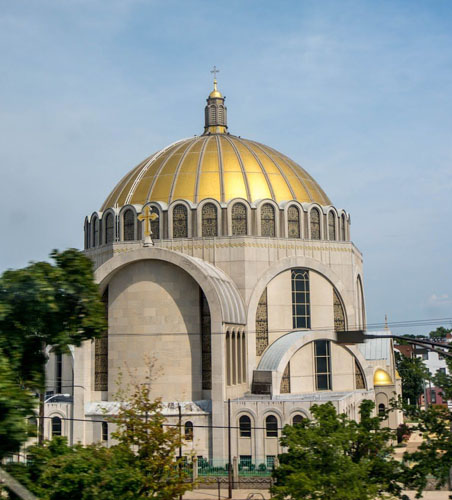Pennsylvania
Pennsylvania. A middle Atlantic state (2020 pop 13,002,700) of the United States of America, covering an area of 119,283 sq km. Its capital is Harrisburg. In 1990, 129,753 of its inhabitants were of Ukrainian origin.
Pennsylvania was the initial focal point of the mass immigration of Ukrainians to the United States of America, which began in 1877–8 when Pennsylvania mining companies began to recruit workers in Transcarpathia. The first recruits were joined soon by volunteers from the neighboring Lemko region and in the 1890s by peasants from eastern Galicia and Bukovyna. Before the First World War Pennsylvania attracted about 75 percent of the Ukrainian immigrants to the United States. Most of them settled in the coal region, in towns such as Shenandoah, Shamokin, Mount Carmel, Hazleton, Lansford, Freeland, Olyphant, and Mayfield. The first organized Ukrainian community in the United States arose in Shenandoah. By 1884 it had acquired the services of a priest, Rev Ivan Ya. Voliansky, and then it built the first church (1886). Before returning to Ukraine Voliansky established another five churches in the region as well as the first Ukrainian-American newspaper, Ameryka; the Little Russian Drama Club; a library and reading room; Saturday and Sunday schools; and co-operative stores. The Ruthenian National Association (later Ukrainian National Association) was founded in Shamokin in 1894 and adopted Svoboda as its organ. To counteract the influence of the Russian Orthodox church among the predominantly Catholic immigrants, the Association of Ruthenian Church Communities in the USA and Canada was organized in 1901. In 1907 Soter Ortynsky was consecrated bishop and apostolic visitator for the Ukrainians and Ruthenians in the United States, and in 1913 he was made exarch. His seat was Philadelphia, where the Providence Association of Ukrainian Catholics in America and the weekly Ameryka (Philadelphia) were set up. Just before the First World War a large number of Ukrainian immigrants joined the work force in the industrial and mining towns of western Pennsylvania. To help the newcomers adjust and establish themselves in the new land, the Ukrainian Workingmen’s Association (now Ukrainian Fraternal Association) was founded in Scranton in 1910, and the Ukrainian National Aid Association of America in Pittsburgh in 1914.
During the First World War Ukrainians in Pennsylvania supported the struggle for independence (1917–20) in Ukraine. In 1916 the Ukrainian National Alliance was formed to publicize Ukrainian political demands, gain official support for them in Washington, DC, and provide relief to war victims.
In the interwar period restrictive laws reduced immigration from Eastern Europe, but the Ukrainian community grew and developed. In 1924 the Ukrainian Catholic exarchy was reorganized into two separate exarchies, a Ukrainian one with its seat in Philadelphia and a Ruthenian (Carpatho-Rusyn) one with its seat in Pittsburgh. At the same time Archbishop Ioan Teodorovych moved the seat of the Ukrainian Orthodox Church in the USA to Philadelphia. The Basilian order of nuns built their motherhouse in Fox Chase (1931) and set up the first Ukrainian academy for girls there. The Ukrainian Catholic Youth League in America, formed in 1933, had its head office in Philadelphia. The first Ukrainian state representative, I. Malena, was elected in Philadelphia.
After the Second World War a large number of new Ukrainian immigrants, including many professionals and others with higher education, came to Pennsylvania. Having settled mostly in Philadelphia, they strengthened the existing Ukrainian institutions and founded new ones: political organizations such as the Organization for the Defense of Four Freedoms for Ukraine; youth organizations, such as the Plast Ukrainian Youth Association and the Ukrainian Youth Association (SUM); and regional associations, such as the Lemkivshchyna and Boikivshchyna societies. Ukrainian language and literature courses were introduced at the University of Pennsylvania in 1959.
Eventually its relative share of the Ukrainian-American population fell, to only 17.5 percent in 1990, but Pennsylvania remains the state most heavily populated by Ukrainians. Its largest Ukrainian communities are found in Philadelphia, Pittsburgh, Scranton, Chester, and Allentown.
BIBLIOGRAPHY
Lushnycky, Alexander. (ed). Ukrainians in Pennsylvania (Philadelphia 1976)
Myron Kuropas
[This article originally appeared in the Encyclopedia of Ukraine, vol. 4 (1993).]

